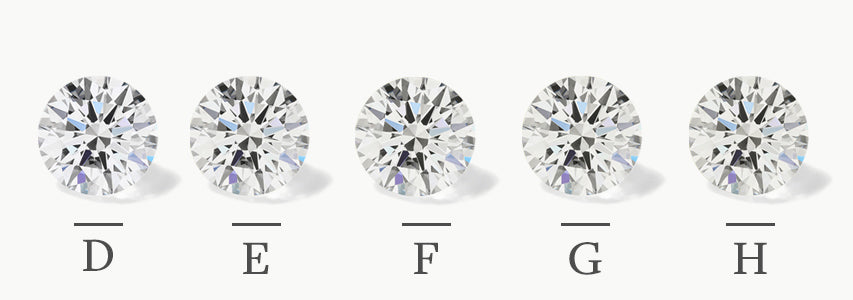What is the HPHT Process to Grow Lab Diamonds?

If you are shopping for the perfect diamond ring or diamond-adorned jewelry, you know that there are plenty of factors to keep in mind such as the diamond's shape, size, and price. But have you come across HPHT diamonds? If this term has you scratching your head, our diamond experts have got you covered. Keep reading to learn everything you need to know about HPHT diamonds and discover if these diamonds are right for you.
TABLE OF CONTENTS
What Are HPHT Diamonds?
HPHT stands for high pressure and high temperature. HPHT is a technique developed in the 1950s to create beautiful and lucrative diamonds. Through HPHT, genuine diamonds can be made from scratch in a controlled environment and existing diamonds can have their color grade improved to make them whiter.
Unlike diamond simulants such as cubic zirconia, moissanite, and white sapphire, HPHT diamonds are real diamonds. These lab made diamonds share the same chemical and physical properties as naturally grown diamonds, which means that they will endure daily wear and always look gorgeous.
How Are HPHT diamonds Made?
Naturally grown diamonds take millions of years to form deep within the earth when exposed to great heat and pressure. Through HPHT, the diamond formation process becomes faster.
The HPHT Process
- The HPHT diamond formation process begins with a small diamond seed that is placed into pure carbon.
- The diamond seed is exposed to intense pressure and heat.
- The carbon melts and a diamond begins to form around the seed.
- The substance is carefully cooled to form a diamond.
- The rough diamond is then ready to be cut, polished, and set into jewelry like a naturally grown rough diamond.
How do Diamonds Receive HPHT Color Treatment?
Most natural white diamonds have hints of yellow or brown in them, which affects their color grade. The HPHT process can be used on natural diamonds to permanently enhance the stone's color to obtain desirable color grades ranging from D to H.

Since the HPHT process is permanent, you will not need to pay for any upkeep to maintain your diamond's stunning color. This way, you can pass your exceptional high pressure, high-temperature diamond down to future generations and it will look just as magnificent as it did on the day of its HPHT treatment.
What Diamonds are Suitable for HPHT Color Treatment?
Many natural diamonds can benefit from an HPHT color grade enhancing treatment. However, not every diamond is suitable for this process. Diamonds with a low clarity grade may crack or break apart during the treatment.
Clarity grade refers to the number of imperfections within the diamond. These imperfections, known as inclusions, can look like dark spots, small cracks, or cloudy areas. The more inclusions a diamond has, the lower its clarity grade.

To receive HPHT treatment, a diamond should have a clarity grade of at least VS2, which is the midway point of the clarity scale. A diamond with a low clarity grade, such as an I3, will break under the HPHT’s intense heat and pressure because of its many internal imperfections that lower the diamond's structural integrity. Read more about diamond clarity grades
What are the Benefits of HPHT Diamonds?
Whether you are buying a diamond formed from by the HPHT process, or need one to undergo an HPHT color enhancement, there are plenty of benefits for you to enjoy:
Affordable:
HPHT diamonds are less expensive than their natural counterparts. Naturally formed diamonds go through a long supply chain that stretches across miners, distributors, cutters, polishers, and jewelers. On the other hand, HPHT formed diamonds, pass through fewer hands and thus incur fewer expenses.
Genuine Diamonds:
The HPHT formed diamonds are just as gorgeous, strong, and versatile as naturally grown diamonds. Moreover, they are chemically and optically identical to natural diamonds.
Permanent Results:
The HPHT color enhancement process is permanent, so you never need to worry about your diamond losing its remarkable color grade. Less upkeep, and more time to admire its sparkly features!
Environmentally Friendly:
Lab grown diamonds typically place less strain on the environment. They do not require mining in mineral deposits.
How to Tell if a Diamond Has Been HPHT Treated
Since the average person cannot tell a natural diamond apart from an HPHT diamond, you should always reference a diamond's official certification.
Diamond certification labs, such as the IGI, employ expert gemologists who will analyze a diamond's characteristics, such as the 4C's, and produce a certificate that details the diamond's information. A certificate from a reputable lab will indicate if a diamond was made through the HPHT process or received any HPHT treatment.
Many diamonds are sold with certifications so customers can know exactly what kind of diamond they are buying. Diamond certificates prevent people from becoming swindled by unscrupulous jewelers who execrate grades and inflate prices, allowing people to shop with confidence.
Where Can I Buy HPHT Diamonds?
At With Clarity, we proudly sell a wide assortment of diamonds, including naturally formed and HPHT grown. All of our HPHT diamonds come with an IGI certificate so you can easily know all of your diamond's characteristics.
From the classic round to the sleek emerald, enjoy our range of HPHT loose diamonds and lab grown diamond engagement rings that accommodate every budget and style.
FAQs
What is an HPHT Diamond?
Are HPHT diamonds real?
Can the HPHT process be used on natural diamonds?
How to tell if a diamond has been HPHT treated?
Where can I buy HPHT diamonds?









